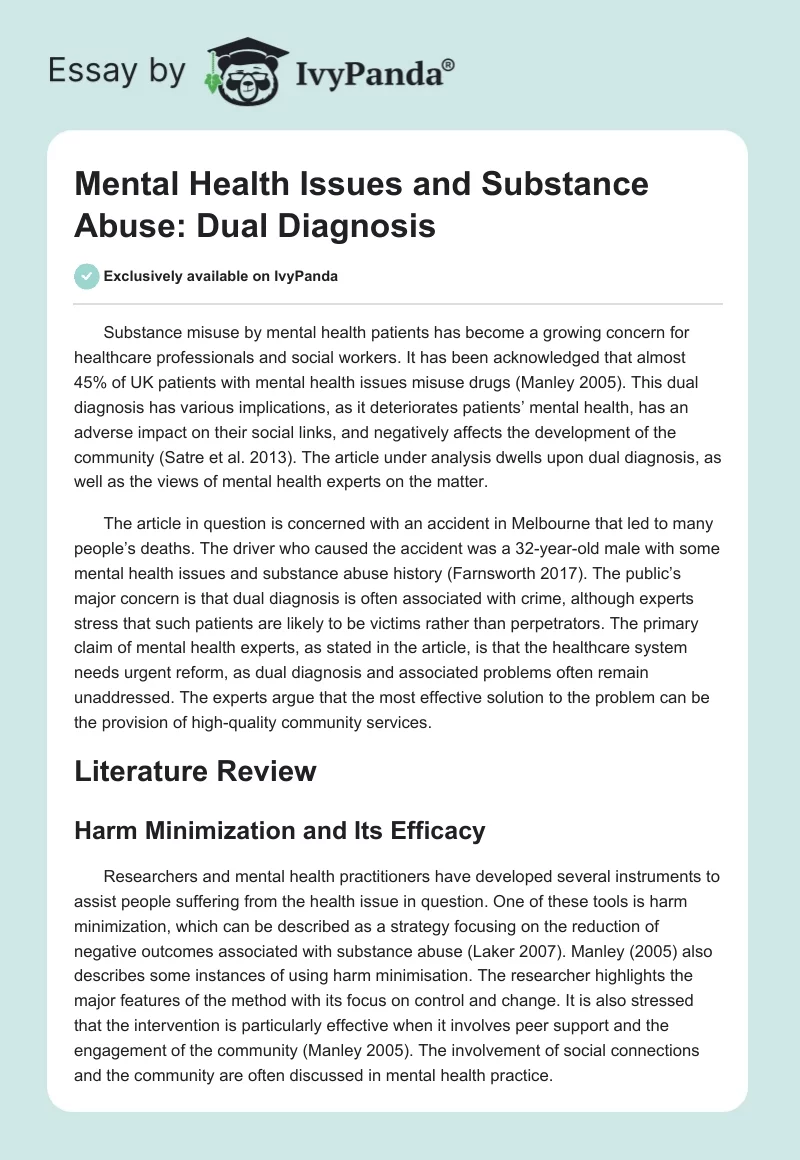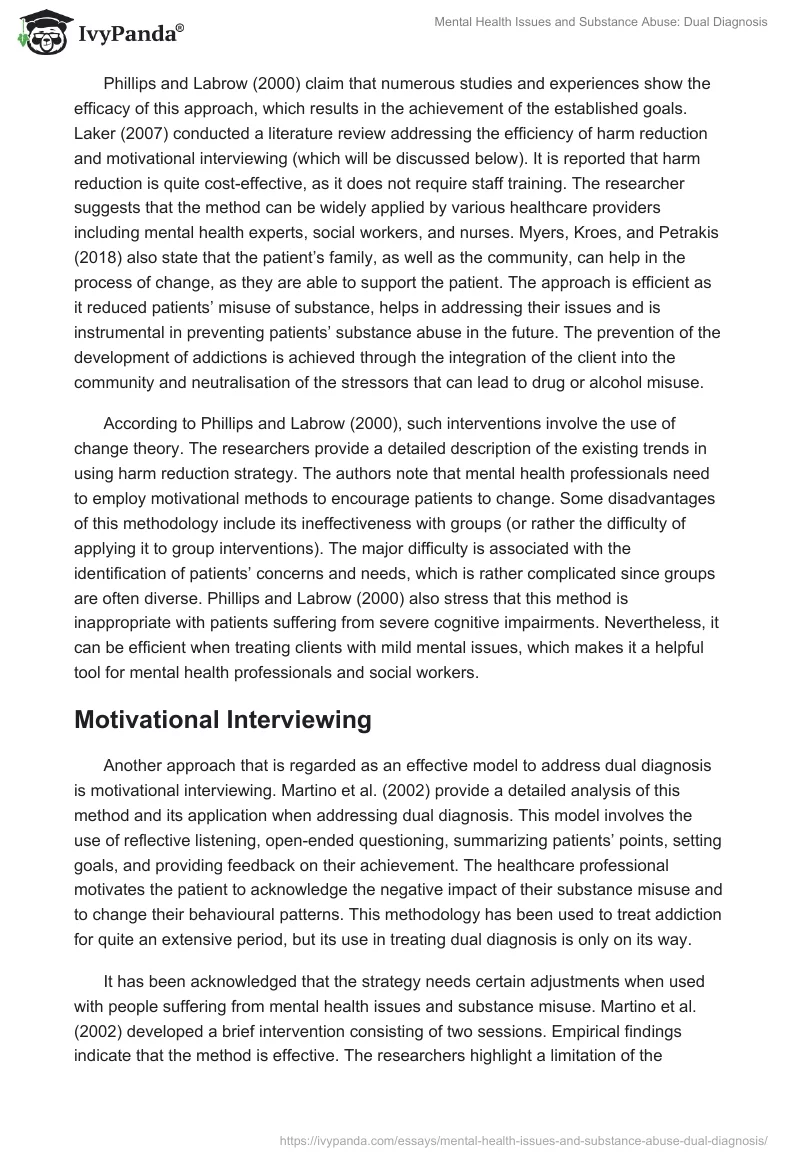Substance misuse by mental health patients has become a growing concern for healthcare professionals and social workers. It has been acknowledged that almost 45% of UK patients with mental health issues misuse drugs (Manley 2005). This dual diagnosis has various implications, as it deteriorates patients’ mental health, has an adverse impact on their social links, and negatively affects the development of the community (Satre et al. 2013). The article under analysis dwells upon dual diagnosis, as well as the views of mental health experts on the matter.
The article in question is concerned with an accident in Melbourne that led to many people’s deaths. The driver who caused the accident was a 32-year-old male with some mental health issues and substance abuse history (Farnsworth 2017). The public’s major concern is that dual diagnosis is often associated with crime, although experts stress that such patients are likely to be victims rather than perpetrators. The primary claim of mental health experts, as stated in the article, is that the healthcare system needs urgent reform, as dual diagnosis and associated problems often remain unaddressed. The experts argue that the most effective solution to the problem can be the provision of high-quality community services.
Literature Review
Harm Minimization and Its Efficacy
Researchers and mental health practitioners have developed several instruments to assist people suffering from the health issue in question. One of these tools is harm minimization, which can be described as a strategy focusing on the reduction of negative outcomes associated with substance abuse (Laker 2007). Manley (2005) also describes some instances of using harm minimisation. The researcher highlights the major features of the method with its focus on control and change. It is also stressed that the intervention is particularly effective when it involves peer support and the engagement of the community (Manley 2005). The involvement of social connections and the community are often discussed in mental health practice.
Phillips and Labrow (2000) claim that numerous studies and experiences show the efficacy of this approach, which results in the achievement of the established goals. Laker (2007) conducted a literature review addressing the efficiency of harm reduction and motivational interviewing (which will be discussed below). It is reported that harm reduction is quite cost-effective, as it does not require staff training. The researcher suggests that the method can be widely applied by various healthcare providers including mental health experts, social workers, and nurses. Myers, Kroes, and Petrakis (2018) also state that the patient’s family, as well as the community, can help in the process of change, as they are able to support the patient. The approach is efficient as it reduced patients’ misuse of substance, helps in addressing their issues and is instrumental in preventing patients’ substance abuse in the future. The prevention of the development of addictions is achieved through the integration of the client into the community and neutralisation of the stressors that can lead to drug or alcohol misuse.
According to Phillips and Labrow (2000), such interventions involve the use of change theory. The researchers provide a detailed description of the existing trends in using harm reduction strategy. The authors note that mental health professionals need to employ motivational methods to encourage patients to change. Some disadvantages of this methodology include its ineffectiveness with groups (or rather the difficulty of applying it to group interventions). The major difficulty is associated with the identification of patients’ concerns and needs, which is rather complicated since groups are often diverse. Phillips and Labrow (2000) also stress that this method is inappropriate with patients suffering from severe cognitive impairments. Nevertheless, it can be efficient when treating clients with mild mental issues, which makes it a helpful tool for mental health professionals and social workers.
Motivational Interviewing
Another approach that is regarded as an effective model to address dual diagnosis is motivational interviewing. Martino et al. (2002) provide a detailed analysis of this method and its application when addressing dual diagnosis. This model involves the use of reflective listening, open-ended questioning, summarizing patients’ points, setting goals, and providing feedback on their achievement. The healthcare professional motivates the patient to acknowledge the negative impact of their substance misuse and to change their behavioural patterns. This methodology has been used to treat addiction for quite an extensive period, but its use in treating dual diagnosis is only on its way.
It has been acknowledged that the strategy needs certain adjustments when used with people suffering from mental health issues and substance misuse. Martino et al. (2002) developed a brief intervention consisting of two sessions. Empirical findings indicate that the method is effective. The researchers highlight a limitation of the suggested methodology, as their brief intervention is likely to be ineffective with patients with severe cognitive impairments. Nevertheless, it has proved to be beneficial for the clients with mild mental issues as they reduced the use of alcohol and drugs. Importantly, patients are encouraged to assess their lifestyles, habits, relationships, and other aspects. Clients start thinking critically about the benefits of healthy habits and opportunities they may have without substance misuse. They are prepared to address their health (and other) issues without misusing alcohol or drugs. Clearly, healthcare professionals and social workers should make sure that the treatment they offer is patient-centred and adjusted to their clients’ specific needs.
Satre et al. (2013) examine the efficacy of motivational interviewing to address hazardous drinking in patients suffering from depression. The researchers note that this approach implies “non-judgmental guidance, helping the patient move to a higher degree of readiness to change and verbalize intent to change” (Satre et al. 2013, p. 323). Satre et al. (2013) developed a brief three-session intervention and examined its effectiveness. Two major components of the model were open-ended questioning and empathetic listening. The authors also claim that conventional motivational interviewing can have limited benefits for the population in question. Their findings show that the suggested program had positive outcomes for the participants. The researchers add that the intervention cannot be used with patients with severe mental issues or serious addiction disorders. They state that the intervention was not in conflict with the primary treatment, which makes it an effective supplementary tool.
Social Work and Dual Diagnosis
As has been mentioned above, the dual diagnosis has appeared in researchers’ and practitioners’ lens rather recently, and limited data and treatment options on the matter are available. The scarcity of information makes it quite challenging for social workers to help patients suffering from mental issues and substance misuse (Alakus & Petrakis 2018). One of the primary challenges related to dual diagnosis lies in that fact that it can be difficult to diagnose the health issues in question, which can have adverse effects on the efficacy of the developed treatment.
Ethical concerns can also prevent social workers from providing high-quality care. According to the Australian Association of Social Workers (2010), social workers should respect patients’ right to self-determination. In simple terms, social workers have to solve a serious ethical dilemma. They have to encourage patients to change and seek help, but patients may choose not to follow recommendations and can remain unmotivated. Such ethical aspects make it quite difficult for social workers to use all the available instruments and help their clients.
Another obstacle for the provision of quality care to the population under analysis is associated with the lack of knowledge, skills, and experience. It has been acknowledged that the curriculum does not incorporate the health issue in question, which makes it difficult for new social workers to help clients effectively (Golightley & Goemans 2017). More importantly, there is a lack of advocacy and even attention to dual diagnosis in mental health practice. Healthcare professionals still tend to treat substance misuse and mental issues separately. Although it may seem that social worker practice includes a limited offer, social workers can effectively help patients with dual diagnosis. In order to achieve this goal, it is important to include this health issue in the curriculum.
At that, social workers can help patients suffering from dual diagnosis using the available approaches and instruments. First, it is pivotal to pay more attention to social aspects instead of focusing on biological factors. Social workers have to consider their clients’ socioeconomic status, cultural background, and social links. It is also helpful to combine different approaches and methods. It is critical to make sure that all the components of the developed treatment are beneficial for the client. Finally, social workers should collaborate with other practitioners to share knowledge and acquire new skills necessary for helping patients.
Conclusion
In conclusion, the two approaches are gaining popularity in mental health practice. Harm reduction strategies involve the mental health expert’s attempts to draw the patient’s attention to the hazards related to their substance misuse. Motivational interviews imply the discussion of patients’ concerns and needs as well as the impact of their substance use. However, to provide high-quality care, social workers should combine these approaches (as well as other tools and methods). Social workers should collaborate with other practitioners as well as the community. It is also critical to incorporate dual diagnosis into the curriculum, which will equip social workers with the necessary background knowledge and skills concerning the health issue.
Reference List
Alakus, C & Petrakis, M 2018, ‘The social worker’s role within an adult mental health interprofessional collaborative team’, in M Petrakis (ed), Social work practice in health, Crows Nest, NSW, pp. 112-127.
Australian Association of Social Workers 2010, Code of ethics. Web.
Farnsworth, S 2017, ‘Melbourne car crash: mental health experts call for reform after Flinders Street carnage’, ABC News. Web.
Golightley, M & Goemans, R 2017, Social work and mental health, Learning Matters, Thousand Oaks, CA.
Laker, CJ 2007, ‘How reliable is the current evidence looking at the efficacy of harm reduction and motivational interviewing interventions in the treatment of patients with a dual diagnosis?’, Journal of Psychiatric and Mental Health Nursing, vol. 14, no. 2, pp. 720-726.
Manley, D 2005, ‘Dual diagnosis: co-existence of drug, alcohol and mental health problems’, British Journal of Nursing, vol. 14, no. 2, pp. 100-106.
Martino, S, Carroll, K, Kostas, D, Perkins, J & Rounsaville, B 2002, ‘Dual diagnosis motivational interviewing’, Journal of Substance Abuse Treatment, vol. 23, no. 4, pp. 297-308.
Myers, K, Kroes, S & Petrakis, M 2018, ‘A foundation for dual diagnosis practice: wisdom, tools and resources’, in M Petrakis (ed), Social work practice in health, Crows Nest, NSW, pp. 128-143.
Phillips, P & Labrow, J 2000, ‘Dual diagnosis — does harm reduction have a role?’ International Journal of Drug Policy, vol. 11, no. 4, pp. 279-283.
Satre, D, Delucchi, K, Lichtmacher, J, Sterling, S & Weisner, C 2013, ‘Motivational interviewing to reduce hazardous drinking and drug use among depression patients’, Journal of Substance Abuse Treatment, vol. 44, no. 3, pp. 323-329.


